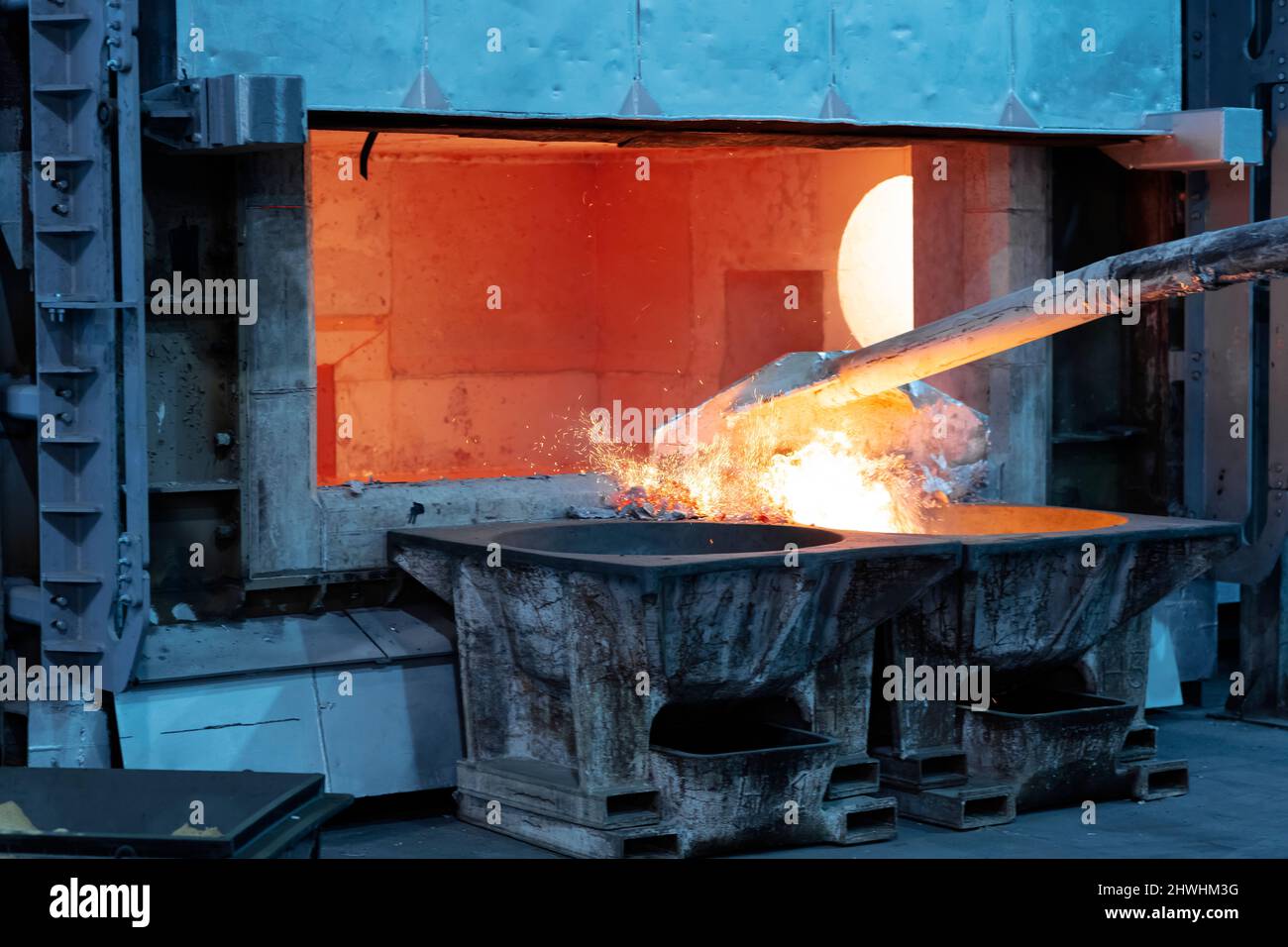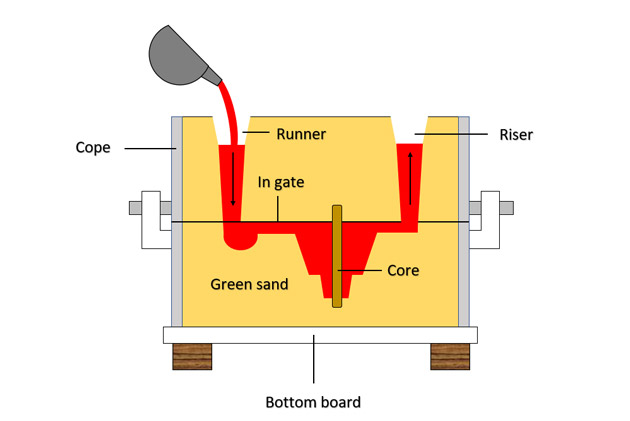How Aluminum Foundry Adds To Developments in Aerospace Design
Aluminum factories are important to improvements in aerospace design. They generate lightweight, high-strength components that are essential for modern-day aircraft. With advanced casting techniques, these shops create intricate geometries that improve structural integrity. Additionally, the advancement of premium Aluminum alloys supports the market's emphasis on gas effectiveness and sustainability. Challenges stay in the production procedure. Understanding these variables reveals the extensive effect of Aluminum on aeronautics's future.
The Value of Lightweight Materials in Aerospace Design
As the aerospace market continues to progress, the importance of lightweight materials comes to be significantly noticeable. The need for efficiency and sustainability drives designers to focus on using materials that reduce total weight without endangering structural honesty. Lightweight products, particularly Aluminum, play a necessary role in improving gas efficiency, improving haul ability, and increasing the total efficiency of aircraft.
The integration of these products enables for innovative styles, making it possible for manufacturers to produce even more aerodynamic shapes that can withstand severe problems. The reduction in weight not just lowers functional costs yet also adds to a lowered ecological footprint, lining up with international efforts toward sustainability in air travel.
Advanced Casting Techniques in Aluminum Foundries
Advanced casting techniques in Aluminum foundries play a critical duty in aerospace engineering by allowing the production of specific and light-weight parts. Developments in mold and mildew layout and accuracy casting processes are important in achieving perfect performance and architectural integrity. Additionally, the growth of light-weight alloys enhances the overall efficiency and effectiveness of aerospace applications.
Ingenious Mold And Mildew Design
Ingenious mold layout plays an important function in the performance and efficiency of Aluminum factories, especially within the aerospace field. By leveraging advanced products and methods, modern-day molds can be engineered to endure high temperature levels and stress, ensuring peak performance during the casting procedure. These designs commonly integrate intricate geometries that permit for the manufacturing of lightweight yet structurally sound parts, crucial for aerospace applications. Furthermore, the usage of computer-aided layout (CAD) software facilitates exact modeling, allowing factories to simulate and fine-tune mold and mildew layouts before physical production begins. This not only boosts the high quality of actors parts yet likewise minimizes waste and preparation, causing substantial cost financial savings. In general, innovative mold and mildew layout is a cornerstone of development in Aluminum Foundry innovation for aerospace engineering.
Accuracy Casting Procedures
The effectiveness of cutting-edge mold and mildew designs perfectly incorporates with accuracy casting procedures, which are important for producing premium Aluminum components in aerospace engineering. These procedures, consisting of sand casting, pass away casting, and investment casting, ensure the creation of complex geometries with limited tolerances. Advanced techniques like vacuum spreading and stress die casting improve the integrity and surface area finish of the end products. Precision casting minimizes product waste while maximizing the mechanical residential or commercial properties of Aluminum, critical for aerospace applications. Furthermore, utilizing real-time surveillance and progressed simulation devices during the casting procedure permits prompt changes, resulting in enhanced quality assurance. Collectively, these precision spreading processes placement Aluminum foundries at the center of aerospace innovation, supporting the industry's need for reliability and performance.
Light-weight Alloy Development
As aerospace designers seek to boost gas effectiveness and performance, light-weight alloy growth becomes an important emphasis in Aluminum shops. These foundries employ innovative casting techniques to produce alloys that supply remarkable strength-to-weight ratios. Developments in alloy structure, including the incorporation of elements like lithium and magnesium, enable the manufacturing of products that endure extreme problems while minimizing general aircraft weight. Methods such as die spreading and financial investment spreading assist in the precision manufacturing of intricate forms, which are critical for aerospace applications. Additionally, ongoing study aims to enhance these alloys for improved mechanical residential properties and boosted sturdiness. By focusing on light-weight alloy growth, Aluminum factories substantially add to the evolution of aerospace engineering, paving the method for more lasting and effective airplane layouts.

Enhancing Structural Stability Through Aluminum Parts
Aluminum elements supply significant advantages in improving structural integrity within aerospace design. Their lightweight nature adds to overall performance while keeping strength, which is necessary for airplane performance. In addition, the stress resistance homes of Aluminum aid assure the longevity and dependability of aerospace frameworks under different operational conditions.
Light-weight Material Perks
While standard products commonly jeopardize weight for strength, utilizing Aluminum components in aerospace engineering uses considerable advantages in structural stability. Aluminum's light-weight nature contributes to total design performance, enabling even more streamlined airplane that eat less fuel, therefore improving sustainability. The material's superb strength-to-weight ratio warranties that parts preserve toughness without including unnecessary mass. This high quality fosters improved efficiency and dexterity in trip, in addition to optimized payload abilities. Additionally, Aluminum's resistance to corrosion prolongs the lifespan of aerospace structures, minimizing upkeep expenses and improving safety and security. As makers progressively take on Aluminum alloys, the aerospace market experiences a transformative shift towards extra effective and reliable engineering solutions that focus on both performance and environmental responsibility.
Stress And Anxiety Resistance Features
Although different products possess one-of-a-kind properties, Aluminum's extraordinary stress and anxiety resistance stands out as an essential consider boosting the structural honesty of aerospace parts. This resistance plays a vital function in ensuring that airplane can hold up against different functional anxieties, including tiredness, impact, and ecological conditions. Aluminum alloys, specifically crafted for aerospace applications, show high tensile stamina while keeping lightweight characteristics, allowing engineers to create a lot more reliable frameworks - Aluminum Foundry. Furthermore, the capability of Aluminum to endure cyclic loading without substantial contortion adds to the longevity and dependability of aerospace elements. As innovations continue in Aluminum Foundry strategies, the growth of stress-resistant Aluminum components guarantees additional renovations in performance, safety, and effectiveness throughout the aerospace sector, strengthening Aluminum's role as a preferred product in modern design
Gas Efficiency Improvements Driven by Aluminum Innovations
As the aerospace market looks for to enhance fuel effectiveness, cutting-edge uses of Aluminum have become a necessary option. Aluminum's lightweight nature significantly reduces aircraft weight, enabling lower fuel usage throughout flight. This decrease in weight is essential, as also little declines can result in significant improvements in general fuel economic climate.
Advanced Aluminum alloys, created for improved strength and longevity, enable producers to develop elements that keep structural stability while decreasing mass - Aluminum Foundry. Furthermore, the integration of Aluminum in airframes and engine elements helps with boosted the rules of aerodynamics, contributing to lowered drag and raised efficiency
The adoption of Aluminum in aerospace not just satisfies the need for fuel-efficient style yet additionally lines up with governing pressures for reduced discharges. As these advancements remain to progress, they play a substantial function in setting brand-new standards for fuel effectiveness, ensuring that the aerospace market can satisfy expanding economic and ecological difficulties.

The Duty of Aluminum in Sustainable Aviation Practices
The increasing focus on lasting air travel methods has actually positioned Aluminum as a vital material in the pursuit for greener airplane layout. Known for its light-weight residential or commercial properties, Aluminum substantially lowers airplane weight, bring about reduced gas usage and emissions. Its recyclability better enhances its linked here sustainability profile, as Aluminum can be recycled forever without advice loss of top quality. This characteristic sustains a round economic climate within the air travel sector, lessening waste and source depletion.
Moreover, advancements in Aluminum alloys have boosted their strength and deterioration resistance, permitting longer solution life and lowered maintenance demands. These innovations help with the advancement of much more efficient airplane frameworks, contributing to general sustainability initiatives. Furthermore, Aluminum's thermal conductivity plays an essential duty in energy-efficient layouts, enhancing systems such as warmth exchangers. Collectively, these characteristics emphasize Aluminum's crucial duty beforehand lasting air travel, straightening with worldwide campaigns intended at reducing the environmental impact of flight.
Difficulties Dealt With by Aluminum Foundries in Aerospace Manufacturing
While Aluminum shops play a vital role in aerospace manufacturing, they deal with considerable difficulties that can impact production effectiveness and top quality. One significant difficulty is the strict top quality control standards called for in the aerospace sector. Any kind of defect can endanger safety and security and performance, demanding strenuous inspection processes that expand production timelines. In addition, factories commonly contend with changing basic material expenses, which can impact pricing and success. The complexity of Aluminum alloys made use of in aerospace applications additional makes complex the production procedure, as precise solutions are important for accomplishing wanted mechanical buildings. Additionally, competent labor shortages impede the ability to maintain top quality production degrees. Ultimately, environmental guidelines impose restrictions on emissions and waste management, requiring foundries to purchase lasting methods, which can be cost-prohibitive. These variables collectively develop a landscape where Aluminum foundries should continually adjust to fulfill the progressing demands of aerospace manufacturing while making certain safety and security and compliance.
Future Patterns in Aluminum Applications for Aerospace Design
With advancements in innovation and enhancing needs for performance, the future of Aluminum applications in aerospace engineering is positioned for considerable change. The assimilation of ingenious Aluminum alloys and composites is expected to improve strength-to-weight proportions, causing more fuel-efficient airplane designs. In enhancement, developments in additive production methods will certainly enable the production of complicated Aluminum frameworks that were previously impossible, optimizing performance and reducing waste.

Lasting methods will certainly play a necessary function, with a growing emphasis on reusing Aluminum to reduce environmental effect. The aerospace industry is likely to welcome smarter producing procedures, such as automation and synthetic knowledge, guaranteeing higher top quality and accuracy in Aluminum elements. Partnerships between Aluminum factories and aerospace firms will foster research and advancement, paving the way for new applications that meet the strict needs of modern aerospace design. Overall, the future looks promising for Aluminum's role fit the skies
Often Asked Inquiries
What Are the Environmental Effects of Aluminum Manufacturing in Aerospace?
The ecological impacts of Aluminum production in aerospace include considerable energy consumption, greenhouse gas emissions, and environment disturbance. Additionally, mining processes can result in soil deterioration and water contamination, increasing concerns concerning sustainability and environmental balance.
Just How Does Aluminum Contrast to Various Other Materials in Aerospace Applications?
Aluminum supplies a special combination of lightweight residential or commercial properties, rust resistance, and cost-effectiveness contrasted to various other materials. Its high strength-to-weight ratio makes it especially useful for aerospace applications, improving gas efficiency and general performance in aircraft style.
What Certifications Do Aluminum Foundry Employees Demand for Aerospace Projects?
Aluminum Foundry workers need specific training in metallurgy and spreading methods, along with understanding of aerospace sector standards. Qualifications in quality assurance and safety and security methods are likewise vital to This Site assure conformity with stringent aerospace job requirements.
Exist Any Type Of Safety Issues With Making Use Of Aluminum in Aerospace Engineering?
Safety and security concerns regarding Aluminum in aerospace engineering include susceptibility to rust, tension, and exhaustion fractures. Correct therapy and alloy choice are necessary to reduce these threats, guaranteeing architectural stability and general safety in aerospace applications.
Exactly How Does Aluminum Recycling Advantage the Aerospace Market?
Aluminum reusing considerably profits the aerospace market by decreasing material prices, decreasing ecological impact, and preserving energy. This sustainable technique boosts the industry's efficiency while advertising using lightweight, high-performance parts in airplane production.
Advanced spreading strategies in Aluminum shops play an essential duty in aerospace design by making it possible for the manufacturing of light-weight and accurate parts. Ingenious mold layout plays a vital duty in the effectiveness and performance of Aluminum shops, specifically within the aerospace industry. As aerospace designers seek to boost gas effectiveness and performance, lightweight alloy growth comes to be a crucial focus in Aluminum foundries. Aluminum alloys, particularly crafted for aerospace applications, exhibit high tensile stamina while preserving light-weight attributes, enabling designers to design more efficient structures. Partnerships in between Aluminum factories and aerospace firms will promote research study and growth, leading the way for new applications that satisfy the rigorous demands of modern-day aerospace engineering.